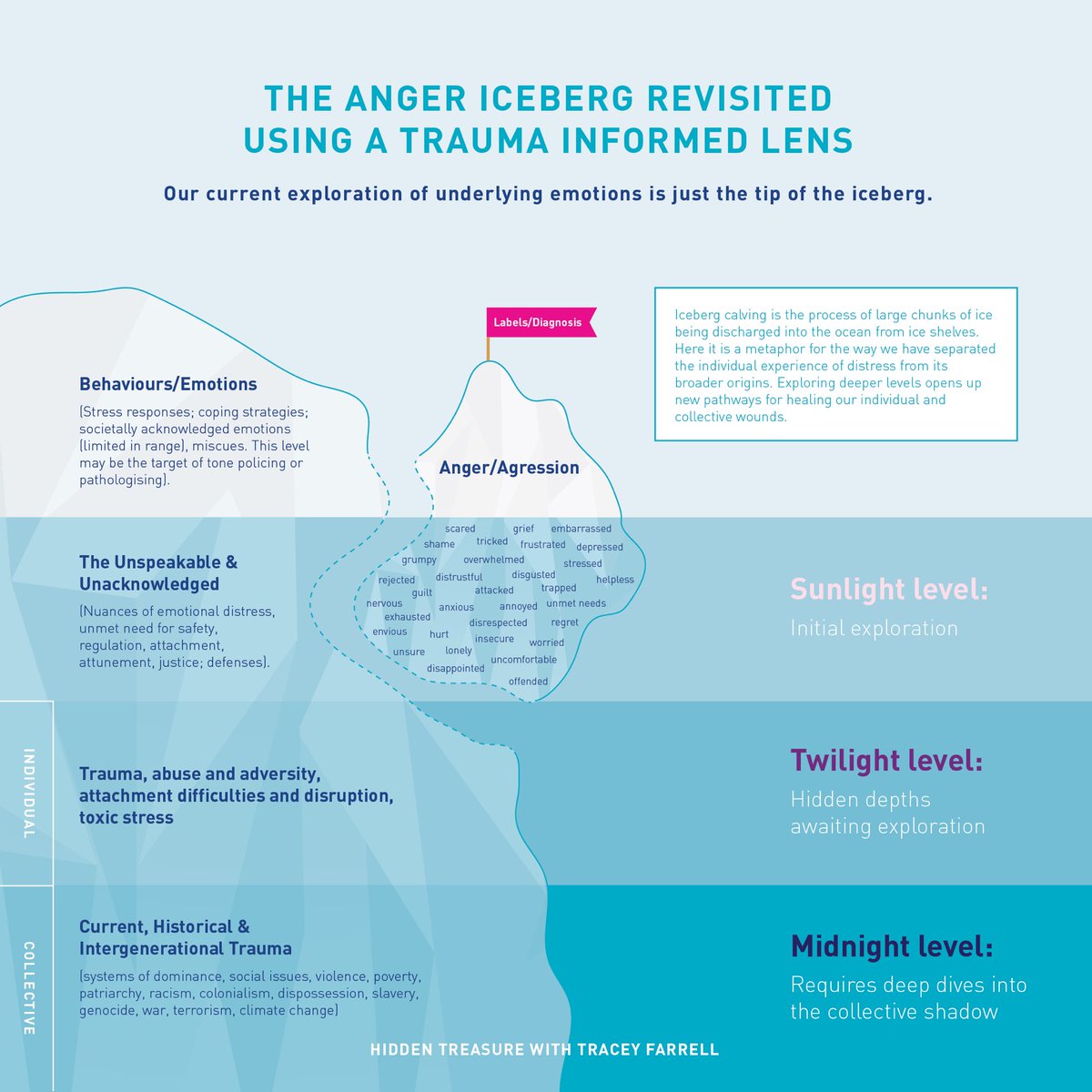1. The Anger Iceberg has been a much needed acknowledgement that underneath visible behaviour and big emotion is other unexpressed emotion that can help us understand how to support a person in their distress.
2. As an example, underneath anger might lie shame which feels so intolerable that it needs to be defended against by aggression. Knowing this, we can empathize more with the persons experience in the moment rather than the events that have unfolded through behaviour.
3. Often though, we stop there. We aren’t curious as to why the person is experiencing shame in the first place. We separate the emotion & resulting behaviour from their origins. We may emphasize but still we find it hard to meet the persons exp with acceptance, & curiosity.
4. Thankfully, we have started to dive deeper. For example, in her book ‘Beyond Behaviors’, Mona Delahooke explores hidden iceberg depths, asking us to consider the thoughts, experiences, individual adversity and developmental concerns that might lead children into using patterns
5. of ‘bad behaviour’ to communicate their unspoken needs.
In this trauma informed and attachment focused revisit of the Anger Iceberg, we see that the iceberg has actually been calved from an much larger ice shelf that has many more layers under the surface.
In this trauma informed and attachment focused revisit of the Anger Iceberg, we see that the iceberg has actually been calved from an much larger ice shelf that has many more layers under the surface.
6. Iceberg calving is the process of large chunks of ice being discharged into the ocean, much like individual behaviour has been orphaned from broader origins of individual trauma, adversity, attachment disruption and difficulties, and even further still from the familial and...
7. collective forms of trauma and adversity, both current and historical.
Our focus on seeing icebergs and not the ice shelves they come from is part of our fascination with individualism at the expense of the collective.
Our focus on seeing icebergs and not the ice shelves they come from is part of our fascination with individualism at the expense of the collective.
8. We have become accustomed to developing services, programs and strategies to address the tip of the iceberg, hoping that treatment of the ‘symptoms’ (and the subsequent labeling of those) will create the change we want to see.
9. Because of this focus, there are hidden depths still waiting to be understood. The depths of the ocean (as well as the iceberg and ice shelf) can be categorised in terms of how much sunlight reaches them
10. - a metaphor for how willing we are to shine light on the experiences of trauma and adversity in a world preoccupied with ‘not reading too much into things’, and avoiding ‘opening a can of worms’ at all costs.
11. In the sunlight level, sun penetrates through so that we can easily see what lies beneath if we are committed to seeing. The next level, the Twilight level, the level of pain associated with our individual experiences of abuse and neglect, toxic stress,
12. and attachment difficulties, has much less light, so we need to take a dive if we wish to explore it. At this level we will need to act purposefully and skillfully to ensure the safety of all that go there.
13. Finally in the Midnight level, which contains our collective trauma and adversity, we find mostly unexplored territory. Some of us know these depths exist and yet only intrepid explorers find their way down.
14 & End. By shining a light on what as been unknown and unacknowledged, misunderstood and side stepped, disowned and denied, we open up new pathways for healing our individual and collective wounds. Who is ready to dive?

 Read on Twitter
Read on Twitter


